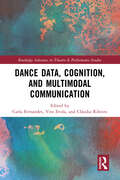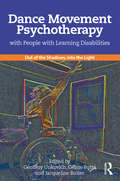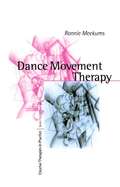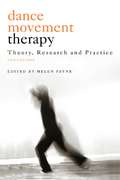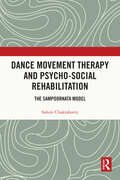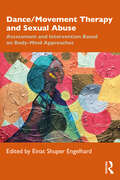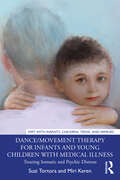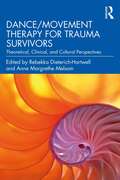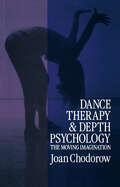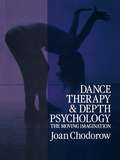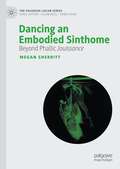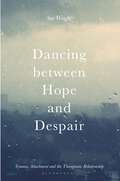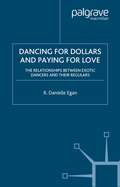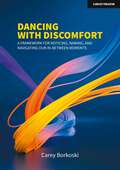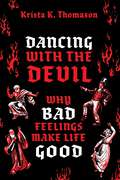- Table View
- List View
Dance Data, Cognition, and Multimodal Communication (Routledge Advances in Theatre & Performance Studies)
by Carla Fernandes Vito Evola Cláudia RibeiroDance Data, Cognition, and Multimodal Communication is the result of a collaborative and transdisciplinary effort towards a first definition of "dance data", with its complexities and contradictions, in a time where cognitive science is growing in parallel to the need of a renewed awareness of the body’s agency in our manyfold interactions with the world. It is a reflection on the observation of bodily movements in artistic settings, and one that views human social interactions, multimodal communication, and cognitive processes through a different lens—that of the close collaboration between performing artists, designers, and scholars. This collection focuses simultaneously on methods and technologies for creating, documenting, or representing dance data. The editors highlight works focusing on the dancers’ embodied minds, including research using neural, cognitive, behavioural, and linguistic data in the context of dance composition processes. Each chapter deals with dance data from an interdisciplinary perspective, presenting theoretical and methodological discussions emerging from empirical studies, as well as more experimental ones. The book, which includes digital Support Material on the volume's Routledge website, will be of great interest to students and scholars in contemporary dance, neuro-cognitive science, intangible cultural heritage, performing arts, cognitive linguistics, embodiment, design, new media, and creativity studies.
Dance Data, Cognition, and Multimodal Communication (Routledge Advances in Theatre & Performance Studies)
by Carla Fernandes Vito Evola Cláudia RibeiroDance Data, Cognition, and Multimodal Communication is the result of a collaborative and transdisciplinary effort towards a first definition of "dance data", with its complexities and contradictions, in a time where cognitive science is growing in parallel to the need of a renewed awareness of the body’s agency in our manyfold interactions with the world. It is a reflection on the observation of bodily movements in artistic settings, and one that views human social interactions, multimodal communication, and cognitive processes through a different lens—that of the close collaboration between performing artists, designers, and scholars. This collection focuses simultaneously on methods and technologies for creating, documenting, or representing dance data. The editors highlight works focusing on the dancers’ embodied minds, including research using neural, cognitive, behavioural, and linguistic data in the context of dance composition processes. Each chapter deals with dance data from an interdisciplinary perspective, presenting theoretical and methodological discussions emerging from empirical studies, as well as more experimental ones. The book, which includes digital Support Material on the volume's Routledge website, will be of great interest to students and scholars in contemporary dance, neuro-cognitive science, intangible cultural heritage, performing arts, cognitive linguistics, embodiment, design, new media, and creativity studies.
Dance Movement Psychotherapy with People with Learning Disabilities: Out Of The Shadows, Into The Light
by Geoffery Unkovich Céline Butté Jacqueline ButlerThis book provides an overview of dance movement psychotherapy for young people and adults with learning disabilities. Contributors from a variety of backgrounds examine their work with clients from across the disabilities spectrum, ranging from mild to complex needs. The book chapters present theory and practice relating to the client group and subsequent therapy processes. This comprises psychotherapeutic interventions, dance movement interventions, theoretical constructs, case study material, practitioner care, and practitioner learning and development related to individual and group therapy work. The logistics of a Dance Movement Psychotherapy intervention, the intervention itself and the ripples of influence into the clients’ wider socio-cultural context are discussed. This stance speaks to current research and practice discourse in health and social care. The book champions acceptance of difference and equality in the health and social care needs for people with learning disabilities whilst emphasising the importance of dance movement psychotherapy for people with non-verbal communication. Dance Movement Psychotherapy with People with Learning Disabilities: Out of the Shadows, into the Light will provide a practical and theoretical resource for practitioners and students of dance movement psychotherapy as well as allied health professionals, service providers and carers.
Dance Movement Psychotherapy with People with Learning Disabilities: Out Of The Shadows, Into The Light
by Geoffery Unkovich Céline Butté Jacqueline ButlerThis book provides an overview of dance movement psychotherapy for young people and adults with learning disabilities. Contributors from a variety of backgrounds examine their work with clients from across the disabilities spectrum, ranging from mild to complex needs. The book chapters present theory and practice relating to the client group and subsequent therapy processes. This comprises psychotherapeutic interventions, dance movement interventions, theoretical constructs, case study material, practitioner care, and practitioner learning and development related to individual and group therapy work. The logistics of a Dance Movement Psychotherapy intervention, the intervention itself and the ripples of influence into the clients’ wider socio-cultural context are discussed. This stance speaks to current research and practice discourse in health and social care. The book champions acceptance of difference and equality in the health and social care needs for people with learning disabilities whilst emphasising the importance of dance movement psychotherapy for people with non-verbal communication. Dance Movement Psychotherapy with People with Learning Disabilities: Out of the Shadows, into the Light will provide a practical and theoretical resource for practitioners and students of dance movement psychotherapy as well as allied health professionals, service providers and carers.
Dance Movement Therapy: A Creative Psychotherapeutic Approach (PDF)
by Dr Bonnie Meekums`This book is a very useful starting point for trainees in DMT, or for those training or practicing in other arts therapies or allied professions who would like an overview of theories and methods in DMT. For more experienced DMT practitioners and researchers, this book provides an introduction to theories of creativity and the notion of the movement metaphor as a basis for DMT theory and practice. There is constant dialogue and contextualizing between Meekum's theory and approach, psychological theories that have influenced the development of DMT, case studies, and the historical development of DMT. What is important in this book is the acknowledgement that DMT is a unique psychotherapy practice with a distinctive theory and methodology based on the intrinsic interaction between movement, the creative process, and psychology' - Body, Movement and Dance in Psychotherapy `Along with the "how" and "why" of psychotherapy, Bonnie Meekums provides realistic examples of people whose lives have benefited from dance movement therapy. It is my honour to recommend this book' - Dianne Dulicai, President of the American Dance Therapy Association `It is a very accessible book - it's an introduction to Dance Movement Therapy, ideal for students who have started DMT training, people who work in related fields (eg other arts therapies) or anyone who is interested in DMT. However, the book goes beyond the introduction in Bonnie's attempt to develop a new framework. It encourages practising DMTs to question their own approach introducing a different terminology to describe the creative process. . . . It is food for thought and for discussions in supervision' - e-motion `Dr Meekums surpasses her goal of contributing to the development of DMT; her book serves as a catalyzing guide for all health care professionals who seek creative processes in healing. . . . Meekums provides an innovative framework for DMT, and offers adequate references and recommendations for further study, research and evidence-based practice. I enthusiastically recommend this book to creative arts therapists, allied practitioners and especially to practicing and interning dance movement therapists as a professional resource and guide' - Maria Brignola Lee, The Arts in Psychotherapy Dance Movement Therapy is a concise, practical introduction to a form of therapy, which has the body-mind relationship at its centre. Movement, with both its physical and metaphorical potential, provides a unique medium through which clients can find expression, reach new interpretations and ultimately achieve a greater integration of their emotional and physical experience. In the book, Bonnie Meekums maps the origins of Dance Movement Therapy (DMT) and its relationship to other more traditional forms of therapy. Outlining a new model for DMT, she describes the creative process, which develops in cycles throughout each session and over the course of therapy. The stages in this creative, psychotherapeutic process are described as: - preparation - incubation - illumination - and evaluation Illustrated throughout with vivid case examples, the book defines the role of the therapist in working with clients to bring about change. This is a practical and accessible guide, which will help new trainees become orientated within the field of DMT. It also has much to offer practising psychotherapists who wish to develop more holistic and creative ways of meeting their clients' needs.
Dance Movement Therapy: A Creative Psychotherapeutic Approach
by Dr Bonnie Meekums`This book is a very useful starting point for trainees in DMT, or for those training or practicing in other arts therapies or allied professions who would like an overview of theories and methods in DMT. For more experienced DMT practitioners and researchers, this book provides an introduction to theories of creativity and the notion of the movement metaphor as a basis for DMT theory and practice. There is constant dialogue and contextualizing between Meekum's theory and approach, psychological theories that have influenced the development of DMT, case studies, and the historical development of DMT. What is important in this book is the acknowledgement that DMT is a unique psychotherapy practice with a distinctive theory and methodology based on the intrinsic interaction between movement, the creative process, and psychology' - Body, Movement and Dance in Psychotherapy `Along with the "how" and "why" of psychotherapy, Bonnie Meekums provides realistic examples of people whose lives have benefited from dance movement therapy. It is my honour to recommend this book' - Dianne Dulicai, President of the American Dance Therapy Association `It is a very accessible book - it's an introduction to Dance Movement Therapy, ideal for students who have started DMT training, people who work in related fields (eg other arts therapies) or anyone who is interested in DMT. However, the book goes beyond the introduction in Bonnie's attempt to develop a new framework. It encourages practising DMTs to question their own approach introducing a different terminology to describe the creative process…. It is food for thought and for discussions in supervision' - e-motion `Dr Meekums surpasses her goal of contributing to the development of DMT; her book serves as a catalyzing guide for all health care professionals who seek creative processes in healing…. Meekums provides an innovative framework for DMT, and offers adequate references and recommendations for further study, research and evidence-based practice. I enthusiastically recommend this book to creative arts therapists, allied practitioners and especially to practicing and interning dance movement therapists as a professional resource and guide' - Maria Brignola Lee, The Arts in Psychotherapy Dance Movement Therapy is a concise, practical introduction to a form of therapy, which has the body-mind relationship at its centre. Movement, with both its physical and metaphorical potential, provides a unique medium through which clients can find expression, reach new interpretations and ultimately achieve a greater integration of their emotional and physical experience. In the book, Bonnie Meekums maps the origins of Dance Movement Therapy (DMT) and its relationship to other more traditional forms of therapy. Outlining a new model for DMT, she describes the creative process, which develops in cycles throughout each session and over the course of therapy. The stages in this creative, psychotherapeutic process are described as: - preparation - incubation - illumination - and evaluation Illustrated throughout with vivid case examples, the book defines the role of the therapist in working with clients to bring about change. This is a practical and accessible guide, which will help new trainees become orientated within the field of DMT. It also has much to offer practising psychotherapists who wish to develop more holistic and creative ways of meeting their clients' needs.
Dance Movement Therapy: Theory, Research and Practice
by Helen PayneWhat can dance movement contribute to psychotherapy? This thoroughly updated edition of Dance Movement Therapy echoes the increased world-wide interest in dance movement therapy and makes a strong contribution to the emerging awareness of the nature of embodiment in psychotherapy. Recent research is incorporated, along with developments in theory and practice, to provide a comprehensive overview of this fast-growing field. Helen Payne brings together contributions from experts in the field to offer the reader a valuable insight into the theory and practice of Dance Movement Therapy. The contributions reflect the breadth of developing approaches, covering subjects including: dance movement therapy with people with dementia group work with people with enduring mental health difficulties transcultural competence in dance movement therapy freudian thought applied to authentic movement embodiment in dance movement therapy training and practice personal development through dance movement therapy. Dance Movement Therapy will be a valuable resource for anyone who wishes to learn more about the therapeutic use of creative movement and dance. It will be welcomed by students and practitioners in the arts therapies, psychotherapy, counselling and other health and social care professions.
Dance Movement Therapy: Theory, Research and Practice
by Helen PayneWhat can dance movement contribute to psychotherapy? This thoroughly updated edition of Dance Movement Therapy echoes the increased world-wide interest in dance movement therapy and makes a strong contribution to the emerging awareness of the nature of embodiment in psychotherapy. Recent research is incorporated, along with developments in theory and practice, to provide a comprehensive overview of this fast-growing field. Helen Payne brings together contributions from experts in the field to offer the reader a valuable insight into the theory and practice of Dance Movement Therapy. The contributions reflect the breadth of developing approaches, covering subjects including: dance movement therapy with people with dementia group work with people with enduring mental health difficulties transcultural competence in dance movement therapy freudian thought applied to authentic movement embodiment in dance movement therapy training and practice personal development through dance movement therapy. Dance Movement Therapy will be a valuable resource for anyone who wishes to learn more about the therapeutic use of creative movement and dance. It will be welcomed by students and practitioners in the arts therapies, psychotherapy, counselling and other health and social care professions.
Dance Movement Therapy and Psycho-social Rehabilitation: The Sampoornata Model
by Sohini ChakrabortyThis book looks at the psychotherapeutic effects of Dance Movement Therapy (DMT) with a focus on the experiences of survivors of gender-based violence and their social development, psycho-social rehabilitation, and reintegration within society. The author, a sociologist and dancer, uses a model she calls Sampoornata— or Fulfilment, to merge sociology and dance in order to help survivors of sexual violence overcome their trauma. Sampoornata was developed to help survivors of gender-based violence and trafficking, by focusing on their specific needs, and helping them to express themselves and overcome emotional and psychological pain. Through interviews with and detailed narratives of survivors, the book takes the readers through the development of the model, its implementation, practice, and impact on their lives. Situated within the social, cultural, as well as geographical context of India, the book is an important resource for rethinking the creative approaches, theories, and practice of DMT worldwide. This book will be of interest to researchers and students of psychology, psychotherapy, dance and movement studies, and to those who work with dance and movement therapy. It will also be useful for professionals working in the areas of gender violence, trafficking, trauma, psycho-social rehabilitation, and well-being.
Dance Movement Therapy and Psycho-social Rehabilitation: The Sampoornata Model
by Sohini ChakrabortyThis book looks at the psychotherapeutic effects of Dance Movement Therapy (DMT) with a focus on the experiences of survivors of gender-based violence and their social development, psycho-social rehabilitation, and reintegration within society. The author, a sociologist and dancer, uses a model she calls Sampoornata— or Fulfilment, to merge sociology and dance in order to help survivors of sexual violence overcome their trauma. Sampoornata was developed to help survivors of gender-based violence and trafficking, by focusing on their specific needs, and helping them to express themselves and overcome emotional and psychological pain. Through interviews with and detailed narratives of survivors, the book takes the readers through the development of the model, its implementation, practice, and impact on their lives. Situated within the social, cultural, as well as geographical context of India, the book is an important resource for rethinking the creative approaches, theories, and practice of DMT worldwide. This book will be of interest to researchers and students of psychology, psychotherapy, dance and movement studies, and to those who work with dance and movement therapy. It will also be useful for professionals working in the areas of gender violence, trafficking, trauma, psycho-social rehabilitation, and well-being.
Dance/Movement Therapy and Sexual Abuse: Assessment and Intervention Based on Body-Mind Approaches
by Einat Shuper EngelhardDance/Movement Therapy and Sexual Abuse addresses the vital role dance/movement therapy plays in helping survivors of sexual abuse. Comprising ten chapters, the book describes assessment, diagnosis and intervention techniques with child, adolescent, and adult survivors of sexual abuse. Using case studies, contributing experts in the field offer the reader a profound understanding of the therapeutic techniques related to movement and the body for the emotional treatment of situations of sexual abuse. The chapters delve into the healing components of treatment during childhood, adolescence, and adulthood, and combine psychodynamic understandings with body-mind theories, techniques from the area of somatic experience, and bio-energetic analysis. Full of in-depth and comprehensive therapeutic interventions using dance/movement therapy to treat sexual trauma, this book will be an essential resource for dance/movement therapists and students of the creative arts therapies.
Dance/Movement Therapy and Sexual Abuse: Assessment and Intervention Based on Body-Mind Approaches
by Einat Shuper EngelhardDance/Movement Therapy and Sexual Abuse addresses the vital role dance/movement therapy plays in helping survivors of sexual abuse. Comprising ten chapters, the book describes assessment, diagnosis and intervention techniques with child, adolescent, and adult survivors of sexual abuse. Using case studies, contributing experts in the field offer the reader a profound understanding of the therapeutic techniques related to movement and the body for the emotional treatment of situations of sexual abuse. The chapters delve into the healing components of treatment during childhood, adolescence, and adulthood, and combine psychodynamic understandings with body-mind theories, techniques from the area of somatic experience, and bio-energetic analysis. Full of in-depth and comprehensive therapeutic interventions using dance/movement therapy to treat sexual trauma, this book will be an essential resource for dance/movement therapists and students of the creative arts therapies.
Dance/Movement Therapy for Infants and Young Children with Medical Illness: Treating Somatic and Psychic Distress (DMT with Infants, Children, Teens, and Families)
by Suzi Tortora Miri KerenThis book presents dance/movement therapy as a window into the emotional and internal experience of a baby with a medical illness, within the context of treating the whole family system and using the DC 0-5 as the basis for formulating the clinical situation. This book fills a gap in the literature, bringing a variety of fields together including infant mental health, infant and child psychiatry, nonverbal-movement analysis, and the creative arts therapies. Grounded in a biopsychosocial perspective, dance/movement therapy is introduced as the main treatment modality, using nonverbal expression as a means of communication, and dance and music activities as intervention tools, to support the child and family. Vignettes from both during and years after the medical experience are presented throughout the book, taking into consideration the subtle and more obvious effects of illness on the child’s later emotional, social, and behavioral development. They illustrate the expertise of the authors as infant mental health professionals, drawing upon their work in hospitals and private practices, and highlight their unique perspectives and years of collaboration. This exciting new book is essential reading for clinicians and mental health professionals working with infants and their families.
Dance/Movement Therapy for Infants and Young Children with Medical Illness: Treating Somatic and Psychic Distress (DMT with Infants, Children, Teens, and Families)
by Suzi Tortora Miri KerenThis book presents dance/movement therapy as a window into the emotional and internal experience of a baby with a medical illness, within the context of treating the whole family system and using the DC 0-5 as the basis for formulating the clinical situation. This book fills a gap in the literature, bringing a variety of fields together including infant mental health, infant and child psychiatry, nonverbal-movement analysis, and the creative arts therapies. Grounded in a biopsychosocial perspective, dance/movement therapy is introduced as the main treatment modality, using nonverbal expression as a means of communication, and dance and music activities as intervention tools, to support the child and family. Vignettes from both during and years after the medical experience are presented throughout the book, taking into consideration the subtle and more obvious effects of illness on the child’s later emotional, social, and behavioral development. They illustrate the expertise of the authors as infant mental health professionals, drawing upon their work in hospitals and private practices, and highlight their unique perspectives and years of collaboration. This exciting new book is essential reading for clinicians and mental health professionals working with infants and their families.
Dance/Movement Therapy for Trauma Survivors: Theoretical, Clinical, and Cultural Perspectives
by Rebekka Dieterich-HartwellThis book offers a timely, detailed, and comprehensive synopsis of dance/movement therapy (DMT) in the treatment of psychological trauma. Along with the foundational concepts of DMT, tied to traditional trauma theory and a neurobiological framework, contributions contain rich clinical examples that illustrate the use of dance, creative movement, and body awareness with a wide variety of populations including survivors of sex trafficking, military veterans, refugees, those with multigenerational trauma, and others. Chapters emphasize the underlying influences of power, privilege, and oppression on trauma, prompting practitioners to consider and understand the dynamics of sociocultural contexts and engage in continuous self-reflection. Featuring multiple perspectives, as well as cultural and contextual considerations, this book provides direct takeaways for clinicians and professionals and concludes with a roadmap for the trajectory of trauma-informed, healing-centered DMT.
Dance/Movement Therapy for Trauma Survivors: Theoretical, Clinical, and Cultural Perspectives
by Rebekka Dieterich-Hartwell Anne Margrethe MelsomThis book offers a timely, detailed, and comprehensive synopsis of dance/movement therapy (DMT) in the treatment of psychological trauma. Along with the foundational concepts of DMT, tied to traditional trauma theory and a neurobiological framework, contributions contain rich clinical examples that illustrate the use of dance, creative movement, and body awareness with a wide variety of populations including survivors of sex trafficking, military veterans, refugees, those with multigenerational trauma, and others. Chapters emphasize the underlying influences of power, privilege, and oppression on trauma, prompting practitioners to consider and understand the dynamics of sociocultural contexts and engage in continuous self-reflection. Featuring multiple perspectives, as well as cultural and contextual considerations, this book provides direct takeaways for clinicians and professionals and concludes with a roadmap for the trajectory of trauma-informed, healing-centered DMT.
Dance Therapy and Depth Psychology: The Moving Imagination
by Joan ChodorowDance/movement as active imagination was originated by Jung in 1916. Developed in the 1960s by dance therapy pioneer Mary Whitehouse, it is today both an approach to dance therapy as well as a form of active imagination in analysis. In her delightful book Joan Chodorow provides an introduction to the origins, theory and practice of dance/movement as active imagination.Beginning with her own story the author shows how dance/ movement is of value to psychotherapy. An historical overview of Jung's basic concepts is given as well as the most recent depth psychological synthesis of affect theory based on the work of Sylvan Tomkins, Louis Stewart, and others. Finally in discussing the use of dance/movement as active imagination in practice, the movement themes that emerge and the non-verbal expressive aspects of the therapaeutic relationship are described.
Dance Therapy and Depth Psychology: The Moving Imagination
by Joan ChodorowDance/movement as active imagination was originated by Jung in 1916. Developed in the 1960s by dance therapy pioneer Mary Whitehouse, it is today both an approach to dance therapy as well as a form of active imagination in analysis. In her delightful book Joan Chodorow provides an introduction to the origins, theory and practice of dance/movement as active imagination.Beginning with her own story the author shows how dance/ movement is of value to psychotherapy. An historical overview of Jung's basic concepts is given as well as the most recent depth psychological synthesis of affect theory based on the work of Sylvan Tomkins, Louis Stewart, and others. Finally in discussing the use of dance/movement as active imagination in practice, the movement themes that emerge and the non-verbal expressive aspects of the therapaeutic relationship are described.
Dancing an Embodied Sinthome: Beyond Phallic Jouissance (The Palgrave Lacan Series)
by Megan SherrittThis book provides the first in-depth analysis of Lacanian psychoanalytic theory and the art of dance and explores what each practice can offer the other. It takes as its starting point Jacques Lacan’s assertion that James Joyce’s literary works helped him create what Lacan terms a sinthome, thereby preventing psychosis. That is, Joyce’s use of written language helped him maintain a “normal” existence despite showing tendencies towards psychosis. Here it is proposed that writing was only the method through which Joyce worked but that the key element in his sinthome was play, specifically the play of the Lacanian real.The book moves on to consider how dance operates similarly to Joyce’s writing and details the components of Joyce’s sinthome, not as a product that keeps him sane, but as an interminable process for coping with the (Lacanian) real. The author contends that Joyce goes beyond words and meaning, using language’s metre, tone, rhythm, and cadence to play with the real, mirroring his experience of it and confining it to his works, creating order in the chaos of his mind. The art of dance is shown to be a process that likewise allows one to play with the real. However, it is emphasized that dance goes further: it also teaches someone how to play if one doesn't already know how. This book offers a compelling analysis that sheds new light on the fields of psychoanalysis and dance and looks to what this can tell us about—and the possibilities for—both practices, concluding that psychoanalysis and dance both offer processes that open possibilities that might otherwise seem impossible. This original analysis will be of particular interest to those working in the fields of psychoanalysis, aesthetics, psychoanalytic theory, critical theory, art therapy, and dance studies.
Dancing between Hope and Despair: Trauma, Attachment and the Therapeutic Relationship
by Sue WrightWhy is hope so fundamental to our existence?In considering this and many other questions, this evocative book introduces the reader to the repeated shifting, or 'dance', between hope and despair that is so often encountered by practitioners working with profoundly traumatised individuals. Drawing on a broad range of theoretical perspectives and illustrated by a wealth of case studies and first-hand experiences, the book brings a sharp focus to the ways in which therapeutic relationships can draw individuals out of the constant oscillation between light and dark. It provides an insightful and thoughtful discussion not just about despair itself, but about how to be with despair: about how practitioners can help clients turn towards the experiences of emotional pain, and stand with them in the face of it. Topics covered include: • The concept of hope, and the differences between realistic and illusory hope• How trauma and attachment failure at different life stages can contribute to the loss of hope• The benefits of taking a highly relational approach to hopelessness, with an emphasis on integrating mind, body and emotions. Informed by the author's own years of experience in the field of psychotherapy, this engaging and stimulating book provides practical guidance on how students, trainees and practitioners can inspire fresh hope in deeply troubled clients.
Dancing for Dollars and Paying for Love: The Relationships between Exotic Dancers and their Regulars
by D. EganThis book takes an in-depth look at the relationships exotic dancers have with their regular customers, and explores the limits of using feminist theory to discuss sex work. This is an accessible, revealing, and new look at a perennially intriguing and divisive subject - ideal teaching material for undergraduate courses in a variety of fields.
Dancing with Discomfort: A framework for noticing, naming, and navigating our in-between moments
by Carey BorkoskiTransitions are universal. They include the important and familiar milestones of starting kindergarten, graduating from high school or college, and becoming employed, parents, or retirees. These transitional moments, however, also include unexpected or unanticipated events like losing a job, joining a running club, or experiencing a global pandemic. In each of these moments, individuals, groups, and organizations experience the anxiety, self-doubt, worry, and uncertainty associated with these novel experiences. Our natural response to these moments is to avoid, side-step, or hurry through until this moment of transition is over. The problem with these strategies is that while we are trying to shut out the unpleasant feelings of those moments, we also miss all the possibilities and discovery. What if we invested time, training, and space to learn, experiment with and strengthen our ability to wrestle with and successfully navigate these moments of transition? Whether a significant transition like moving into a new school or just shifting from one project to the next, we need to build strategies and techniques to leverage and learn from the discomfort that individuals experience during these moments. This book offers names and faces for our feelings, thoughts, and reactions in our transitions. It is based on sound research and data collected by the author and other researchers but is also based on the author’s experiences, mistakes, reflection, and learning from doing the work in different contexts. It includes a framework to learn to stay in these transitions, embrace dissonance, and leverage these moments of discovery. Whether you want to introduce this transitions framework and strategies in a classroom, boardroom, or your own life, this book is for you and your organization to start the intentional work to create spaces, and time to name, feel, explore, reflect on, and move through the myriad transitions occurring during our personal and professional journeys.
Dancing with Discomfort: A framework for noticing, naming, and navigating our in-between moments
by Carey BorkoskiTransitions are universal. They include the important and familiar milestones of starting kindergarten, graduating from high school or college, and becoming employed, parents, or retirees. These transitional moments, however, also include unexpected or unanticipated events like losing a job, joining a running club, or experiencing a global pandemic. In each of these moments, individuals, groups, and organizations experience the anxiety, self-doubt, worry, and uncertainty associated with these novel experiences. Our natural response to these moments is to avoid, side-step, or hurry through until this moment of transition is over. The problem with these strategies is that while we are trying to shut out the unpleasant feelings of those moments, we also miss all the possibilities and discovery. What if we invested time, training, and space to learn, experiment with and strengthen our ability to wrestle with and successfully navigate these moments of transition? Whether a significant transition like moving into a new school or just shifting from one project to the next, we need to build strategies and techniques to leverage and learn from the discomfort that individuals experience during these moments. This book offers names and faces for our feelings, thoughts, and reactions in our transitions. It is based on sound research and data collected by the author and other researchers but is also based on the author's experiences, mistakes, reflection, and learning from doing the work in different contexts. It includes a framework to learn to stay in these transitions, embrace dissonance, and leverage these moments of discovery. Whether you want to introduce this transitions framework and strategies in a classroom, boardroom, or your own life, this book is for you and your organization to start the intentional work to create spaces, and time to name, feel, explore, reflect on, and move through the myriad transitions occurring during our personal and professional journeys.
Dancing with the Devil: Why Bad Feelings Make Life Good
by Krista K. ThomasonJust as a garden needs worms, we need bad feelings.... We tend to think about bad feelings--feelings like anger, envy, spite, and contempt--as the weeds in life's garden. You may not be able to get rid of them completely, but you're supposed to battle them as best you can. The best garden is one with no weeds. The best life is one with no bad feelings. But this isn't quite right, according to philosopher Krista K. Thomason. Bad feelings are the worms, not the weeds. They're just below the surface, and we like to pretend they aren't there, but they serve an important purpose. Worms are just as much a part of the garden as the flowers, and their presence means your garden is thriving. Gardens aren't better off without their worms, and neither are we. The trick is learning how to enjoy our gardens, worms and all. Thomason draws on insights from the history of philosophy to show what we've gotten wrong about bad feelings and to show readers how we can live better with them. There is nothing wrong with negative emotions per se. Their bad reputation is undeserved. Negative emotions are expressions of self-love--not egoism or selfishness, but the felt attachment to ourselves and to our lives. We feel negative emotions because our lives matter to us. After explaining this, Thomason helps us look at individual bad feelings: anger, envy and jealousy, spite and Schadenfreude, and contempt. As she demonstrates in this tour of negative emotions, these feelings are valuable parts of our attachment to our lives. We don't have to battle negative emotions or "channel" them into something productive. Bad feelings aren't obstacles to a good life; they are part of what makes life meaningful.
Dancing with the Devil: Why Bad Feelings Make Life Good
by Krista K. ThomasonJust as a garden needs worms, we need bad feelings.... We tend to think about bad feelings--feelings like anger, envy, spite, and contempt--as the weeds in life's garden. You may not be able to get rid of them completely, but you're supposed to battle them as best you can. The best garden is one with no weeds. The best life is one with no bad feelings. But this isn't quite right, according to philosopher Krista K. Thomason. Bad feelings are the worms, not the weeds. They're just below the surface, and we like to pretend they aren't there, but they serve an important purpose. Worms are just as much a part of the garden as the flowers, and their presence means your garden is thriving. Gardens aren't better off without their worms, and neither are we. The trick is learning how to enjoy our gardens, worms and all. Thomason draws on insights from the history of philosophy to show what we've gotten wrong about bad feelings and to show readers how we can live better with them. There is nothing wrong with negative emotions per se. Their bad reputation is undeserved. Negative emotions are expressions of self-love--not egoism or selfishness, but the felt attachment to ourselves and to our lives. We feel negative emotions because our lives matter to us. After explaining this, Thomason helps us look at individual bad feelings: anger, envy and jealousy, spite and Schadenfreude, and contempt. As she demonstrates in this tour of negative emotions, these feelings are valuable parts of our attachment to our lives. We don't have to battle negative emotions or "channel" them into something productive. Bad feelings aren't obstacles to a good life; they are part of what makes life meaningful.
